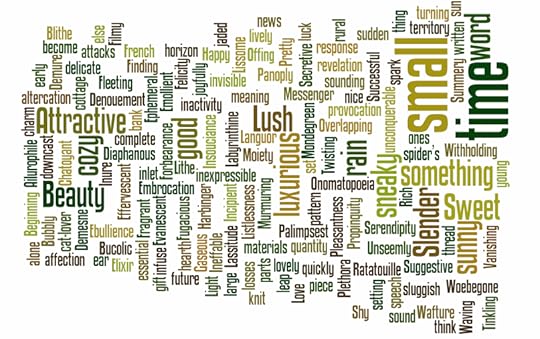Jacqui Murray's Blog, page 165
June 25, 2013
Tech Tips for Writers #55: Find a Lost Shortcut
 Tech Tips for Writers is an (almost) weekly post on overcoming Tech Dread. I’ll cover issues that friends, both real-time and virtual, have shared. Feel free to post a comment about a question you have. I’ll cover it in a future Tip.
Tech Tips for Writers is an (almost) weekly post on overcoming Tech Dread. I’ll cover issues that friends, both real-time and virtual, have shared. Feel free to post a comment about a question you have. I’ll cover it in a future Tip.
Q: I can’t find the shortcut for a program I want to open. It’s not on the desktop, on the start menu or in ‘all programs’. How do I open the program?
A: Try ‘Start button’, then type in the name of the program where it says ‘start search’. The shortcut shows up.
Questions you want answered? Email me at askatechteacher@gmail.com.
Jacqui Murray is the author of the popular Building a Midshipman , the story of her daughter’s journey from high school to United States Naval Academy. She is webmaster for six blogs, an Amazon Vine Voice book reviewer, a weekly columnist for Examiner.com and TeachHUB, Editorial Review Board member for Journal for Computing Teachers, Cisco guest blog, IMS tech expert, and a monthly contributor to Today’s Author. In her free time, s he is the editor of a K-8 technology curriculum, K-8 keyboard curriculum, K-8 Digital Citizenship curriculum, and creator of technology training books for how to integrate technology in education. Currently, she’s editing a thriller that should be out to publishers next summer. Contact Jacqui at her writing office or her tech lab, Ask a Tech Teacher.
Filed under: problem-solving, tech tips for writers, writers tips, writing Tagged: tech tips for writers, writers tips


June 24, 2013
Writers Tip #53: What Motivates Your Character Provides Conflict
 When you read your story, does it sound off, maybe you can’t quite put your finger on it, but you know you’ve done something wrong? Sometimes–maybe even lots of times–there are simple fixes. These writer’s tips will come at you once a week, giving you plenty of time to go through your story and make the adjustments.
When you read your story, does it sound off, maybe you can’t quite put your finger on it, but you know you’ve done something wrong? Sometimes–maybe even lots of times–there are simple fixes. These writer’s tips will come at you once a week, giving you plenty of time to go through your story and make the adjustments.
Today’s tip: Know what motivates your characters
Motivation is to a character what conflict is to a plot, but on a personal level. What motivates your character is what they’re striving to achieve, but haven’t, what they dream of, but don’t have. They spend the entire novel trying to resolve that. Their growth throughout the story will reflect their success. Struggle is far more compelling than satisfaction. This character growth is part of what will make page-turners out of your readers. By the end of the novel, your audience should feel a sense of accomplishment with the character in what s/he has achieved.
In yourself–and your friends–actions and reactions are driven by a core of morals, beliefs, goals, desires. Nothing you do occurs without impact from those factors. So too, it must be with your characters, but how do you know what is? In my current novel, I wrote a prequel so I could hash out how my cast would react in every situation I threw at them. Only then did I know them enough to write their story. There are other, less time-consuming ways. Some suggest writing a detailed description. Some interview their characters, Others write scenes. The last conference I went to suggested writing a list of characteristics, then picking three and keeping those on your desktop for reference every time you write that individual in a scene.
Whatever way you choose, do it. If they are spiritual, this bleeds into their scenes. If having children is important to them, this will shade their relationships. If it’s politics, this may influence how they succeed at work. Your reader will want to see how each character resolves these internal conflicts and will want to see their growth throughout the novel. If you’ve wrapped the character as a person into the plot, this will happen naturally. If it doesn’t, go back and re-evaluate, find the parts that don’t sound authentic. These conflicts are what makes your character memorable and gives you a grip on the reader. Glory in them.
–Click to have Writer’s Tips delivered to your email box
Jacqui Murray is the author of the popular Building a Midshipman , the story of her daughter’s journey from high school to United States Naval Academy. She is webmaster for six blogs, an Amazon Vine Voice book reviewer, a weekly columnist for Examiner.com and TeachHUB, Editorial Review Board member for Journal for Computing Teachers, Cisco guest blog, IMS tech expert, and a monthly contributor to Today’s Author. In her free time, she is editor of a K-8 technology curriculum, K-8 keyboard curriculum, K-8 Digital Citizenship curriculum, and creator of technology training books for how to integrate technology in education. Currently, she’s editing a thriller that should be out to publishers next summer. Contact Jacqui at her writing office or her tech lab, Ask a Tech Teacher.
Filed under: characters, writers resources, writers tips, writing Tagged: characters, conflict, motivation, writers resources, writing tips


June 22, 2013
Sell Your Books Online
 Have you written a book? Or do you–like 62% of people–have a book inside of you fighting for its place in the world? Do you think the only place you can sell your books is Amazon Kindle? Did you try to publish through [fill in the blank with a publisher or agent name] and get rejected? As did every publisher/agent you contacted? So you’ve self-published and now wonder what to do next?
Have you written a book? Or do you–like 62% of people–have a book inside of you fighting for its place in the world? Do you think the only place you can sell your books is Amazon Kindle? Did you try to publish through [fill in the blank with a publisher or agent name] and get rejected? As did every publisher/agent you contacted? So you’ve self-published and now wonder what to do next?
If you write tech books–fiction or non-fiction–or run an online tech ed class, there’s a new marketplace available at Structured Learning. It seems to be a hybrid of Amazon, Teachers Pay Teachers, and Alibris. You pay a set-up fee and a monthly maintenance fee, but get all proceeds of your sales. They don’t even handle the money–it goes to a store you’ve designated for that purpose.
The set-up fee includes review of your book, comments to improve it, and requirements so it meets the layout standards of products sold on the website. For example, if you want to sell a historic fiction book, this wouldn’t be the right place, but if you have tech fiction for K-8, it would. Does that make sense?
What types of books are they looking for? Here are some categories:
anything to help teachers with Common Core
books for beginning teachers
how to integrate tech into classrooms
flipped classrooms
literacy
digital citizenship
how to ___________(fill in the blank with a tech skill)
parent guide to a digital world
using interactive whiteboards in the classroom
principals and the digital school
online tech ed classes (they offer two right now and would like to offer more)
I have a couple of books published through Structured Learning, so feel free to ask questions. I’ll share what I know.
OK, back to writing my thriller…
Jacqui Murray is the author of the popular Building a Midshipman , the story of her daughter’s journey from high school to United States Naval Academy. She is webmaster for six blogs, an Amazon Vine Voice book reviewer, a columnist for Examiner.com and TeachHUB, Editorial Review Board member for Journal for Computing Teachers, Cisco guest blogger, Technology in Education featured blogger, and IMS tech expert. She is the editor of a K-6 technology curriculum, K-8 keyboard curriculum, K-6 Digital Citizenship curriculum, creator of technology training books for middle school and ebooks on technology in education. Currently, she’s editing a thriller that should be out to publishers next summer. Contact Jacqui at her writing office or her tech lab, Ask a Tech Teacher.
Filed under: authors, business


June 21, 2013
Book Thoughts: The Forest People
 I’ve been reading Colin Turnbull’s The Forest People. He lived ‘a while’ with pygmies to understand their life, their ‘culture’, their beliefs. Turnbull doesn’t lecture, or present the material as an ethnography. It’s more like a biography of a tribe. As such, I get to wander through their lives, see what they do, how they do it, what’s important to them, without any judgments or conclusions other than my own. What a treat for a writer! A chance to explore a culture, understand their decisions, life style, what makes a society other than mine/ours work.
I’ve been reading Colin Turnbull’s The Forest People. He lived ‘a while’ with pygmies to understand their life, their ‘culture’, their beliefs. Turnbull doesn’t lecture, or present the material as an ethnography. It’s more like a biography of a tribe. As such, I get to wander through their lives, see what they do, how they do it, what’s important to them, without any judgments or conclusions other than my own. What a treat for a writer! A chance to explore a culture, understand their decisions, life style, what makes a society other than mine/ours work.
It didn’t take me long to realize Pygmies have no leaders. How can that be, you might ask? Doesn’t somehow just assume that mantle? Well, until I read this book, I would have agreed whole-heartedly, but that doesn’t seem to happen. A tribe member might demand everyone go hunting with him (it takes a large group to capture/kill the forest animals) and people may go, or they may not. Whatever they feel like. When they move to a new camp, houses and furniture must be built. People may start full of energy and ambition, promising to help neighbors and build big houses with multiple rooms. And then dwindle away as something else grabs their attention. Maybe finish, maybe not. Maybe use some of their neighbor’s roof leaves, or even his house since theirs isn’t built.
Most surprisingly, I have yet to discover a belief in a god. They don’t pray for help, for food or safety, for anything. If life doesn’t seem quite right, the closest they get to wishing it was better is to return to the forest where life is always good. So they do, to a camp surrounded by the depths of the jungle, where outsiders are afraid to go. But the forest isn’t their god, it’s merely where life is always good.
Hmmm. I have to ponder this…
Jacqui Murray is the author of the popular Building a Midshipman , the story of her daughter’s journey from high school to United States Naval Academy. She is webmaster for six blogs, an Amazon Vine Voice book reviewer, a columnist for Examiner.com and TeachHUB, Editorial Review Board member for Journal for Computing Teachers, Cisco guest blog, Technology in Education featured blogger, IMS tech expert, and a bi-monthly contributor to Today’s Author. In her free time, s he is the editor of a K-8 technology curriculum, K-8 keyboard curriculum, K-8 Digital Citizenship curriculum, and creator of technology training books for how to integrate technology in education. Currently, she’s editing a thriller that should be out to publishers next summer. Contact Jacqui at her writing office or her tech lab, Ask a Tech Teacher.
Filed under: characters, writers resources Tagged: Africa, culture, pygmy


June 20, 2013
5 Writing Goals for Summer
 Ah, summer. Is it really that time again? It’s hard to believe I’ll have two months to do whatever I want–clean my house, walk the dog, read, pursue educational enrichment, catch up on my writing, talk to my children–talk to my husband.
Ah, summer. Is it really that time again? It’s hard to believe I’ll have two months to do whatever I want–clean my house, walk the dog, read, pursue educational enrichment, catch up on my writing, talk to my children–talk to my husband.
Truth, I have more to do than two months of free time. I know what I should do–hone my teacher skills–but I want to work on my writing skills. I’ve waited all these years, putting children and husband first (and happy I did), then falling into a teaching job where my students go first (400 wide-eyed, eager brains. Never could talk myself into going on auto-pilot). When is it My Time?
This summer. I’m doing it. I am going to devote myself to my writerly craft and see what happens. I know–I’m a little nuts. Let’s stipulate to that and move on. Here’s my list of the top five ways I will spend my Writerly Summer:
Writing
I have two non-fic books my publisher awaits. I have five more ebooks batting around in my brain I can dash off without too much trouble, then sell on my Teachers Pay Teachers account (see below). I also must MUST finish Twenty-four Days. I’m either going to make my publisher happy or I’m going to have a Come to Jesus moment and make a Big Decision. Either way, that book is being birthed this summer.
That done, I want to rework the prequel to Twenty-four Days so its ready to go as the next in the series. Because I know readers will rabidly want more.
That done (here’s the tie-in to this month’s theme: what was I doing half a lifetime ago), I am going to rewrite the book that started me authoring–Lucy: A Biography. It’s the saga of our ancestors. I’m going to revamp it in first person so readers can relate to their roots better. I sure hope that works. Well, it will work because I’ll self-pub when I’m done (it’s a niche topic that has garnered little publisher/agent interest in the 15 years it’s been kicking around).
This is a great site to sell teaching materials to teachers. If you haven’t visited TPT, you are missing out. There is a wealth of resources on everything imaginable sold by people just like you (if you’re a teacher and a writer). It includes a robust ‘comment’ section for products where I get lots of feedback on my materials. The hitch: All customers are teachers. So, writing materials should be geared toward teaching K-12. Despite that, this is a great marketplace for me which often outsells Amazon. I need to look over my TPT store, make sure everything is current, crisp, presentable, then update as needed.
These are great. An expert alerts you s/he will be ‘hanging out’ at a certain date and time. The first ten people who accept her invitation are on-screen with her/him. She presents writing tips and tricks and you (as one of the first 10) get to participate in the conversation. The expert benefits because s/he can tape directly to her/his YouTube channel of writing tips (you have one, right?). The viewer also wins because they get amazing writing advice for free. I teach technology education through Google Hangouts (as part of CSG online classes) and am loving it, as are my students (all adults). Trust me, fellow writers, this is the future of learning. Embrace it. All it takes is a little practice to get down the invitation process, how to record to YouTube, get screenshare linked to Google Docs, and get that comment sidebar up so everyone can talk at once.
Online seminars
You might call them ‘webinars’. I get lots of invitations, but put them off because I’m either working when the event takes place or too tired. No excuses anymore–I’ll do it!
Go Digital!
I will force myself to do everything possible digitally. No more newspapers (go online), no more paperback books, no more paper and pencil notes (I’ll learn Evernote). No more printed directions–I’ll figure out how to send them to my phone. No more trips to the library–I will use the online catalog. What else? Doesn’t matter what else. Anything else that comes up, I will try to find a digital solution to. I can do it!
There you have it. What are your summer plans?
Jacqui Murray has been teaching K-8 technology for 15 years. She is the editor of a K-8 technology curriculum, K-8 keyboard curriculum, K-8 Digital Citizenship curriculum, and creator of technology training books for how to integrate technology in education. She is webmaster for six blogs, CSG Master Teacher, an Amazon Vine Voice book reviewer, Editorial Review Board member for Journal for Computing Teachers, Cisco guest blogger, a columnist for Examiner.com, featured blogger for Technology in Education, IMS tech expert, and a monthly contributor to TeachHUB. Currently, she’s editing a techno-thriller that should be out to publishers next summer. Contact Jacqui at her writing office or her tech lab, Ask a Tech Teacher.
Filed under: writing Tagged: summer, writing


June 18, 2013
Tech Tips for Writers #54: How to Auto Forward a PowerPoint Slideshow
 Tech Tips for Writers is an (almost) weekly post on overcoming Tech Dread. I’ll cover issues that friends, both real-time and virtual, have shared. Feel free to post a comment about a question you have. I’ll cover it in a future Tip.
Tech Tips for Writers is an (almost) weekly post on overcoming Tech Dread. I’ll cover issues that friends, both real-time and virtual, have shared. Feel free to post a comment about a question you have. I’ll cover it in a future Tip.
Q: My students are learning to use Powerpoint for presentations. They’ll stand in front of the class and the slideshow will play behind them. We want it to go automatically without requiring them to click the mouse or push the space bar. How do we do that?
A: Presentations are a great skill to teach students. I applaud you on this. Auto-forward isn’t difficult:
go to Transition on the menu bar
go to Timing on the right side
Leave ‘on mouse click’ selected (in case you as the teacher need to move it forward automatically. I’ve had students mistakenly put five minutes on a slide instead of five seconds and we would sit waiting forever if I didn’t do the mouse click)
set the timer to serve the needs of the slide. This will require students to practice before presenting so they can put the correct time in. A good default of 5-10 seconds.

Questions you want answered? Email me at askatechteacher@structuredlearning.net.
Jacqui Murray is the author of the popular Building a Midshipman , the story of her daughter’s journey from high school to United States Naval Academy. She is webmaster for six blogs, an Amazon Vine Voice book reviewer, a columnist for Examiner.com and TeachHUB, Editorial Review Board member for Journal for Computing Teachers, Cisco guest blog, Technology in Education featured blogger, IMS tech expert, and a bi-monthly contributor to Today’s Author. In her free time, s he is the editor of a K-8 technology curriculum, K-8 keyboard curriculum, K-8 Digital Citizenship curriculum, and creator of technology training books for how to integrate technology in education. Currently, she’s editing a thriller that should be out to publishers next summer. Contact Jacqui at her writing office or her tech lab, Ask a Tech Teacher.
Filed under: problem-solving, tech tips for writers, writers tips, writing Tagged: Powerpoint, tech tips for writers, writers tips


June 17, 2013
Writers Tip #52: Join a Writers Groups
 When you read your story, does it sound off, maybe you can’t quite put your finger on it, but you know you’ve done something wrong? Sometimes–maybe even lots of times–there are simple fixes. These writer’s tips will come at you once a week, giving you plenty of time to go through your story and make the adjustments.
When you read your story, does it sound off, maybe you can’t quite put your finger on it, but you know you’ve done something wrong? Sometimes–maybe even lots of times–there are simple fixes. These writer’s tips will come at you once a week, giving you plenty of time to go through your story and make the adjustments.
Today’s tip: Join a Writers Group
It’s been almost a year since I talked about writer’s groups. I haven’t changed my mind. I still think it’s one of the important steps new writers should take. Established writers: The right group is a godsend to your future books–but it has to be other published writers who are knowledgeable in your genre.
In this internet age, it’s not as hard as it used to be to find a writer’s critique group. Try:
a bookstore
the local library
Goodreads under that category
the local community college
Online
I found mine (it’s in Aliso Viejo California. Add a comment if you’d like more information on them) through the local bookstore.
Here’s what’s important: Find one with writers whose work you like and who are supportive of each other. Lurk and learn by reading their comments and critiques until you are ready to write. Many agents want to know your work has been edited before they look at it. A writer’s group will get you started without spending the hundreds it will cost to have a mss professionally edited. They’ll get you close before the pros take over.
Writers Digest described the different personalities you run across in a writer’s group. As I read this, I identified every member of my group. The people they don’t describe are the good writers who sincerely want to help others. I have a few of those, too, but maybe they’re a rarity:
Some yellow brick roads lead down dark alleys where unsavory literary types lurk. These are the Critique Group Killers. While different personalities bring depth to a group, personality clashes bring depth with an anchor attached. If you want a group that makes you want to write, to improve, to succeed, avoid the following:
Drama Queens. “Hello, spotlight.” These writers were born ready for their close-up and will do anything to make sure the group revolved around them. If you want theater, buy a ticket.
Non-Writers. You’ll know them because they don’t give out review pages. To anyone. These smooth operators have a great line and some fabulous stories. Don’t allow them to talk you into letting them join, or remain, in your group.
Self-Professed Prolific Writers. They’ll give you tons of pages—pages that need vast amounts of work. Equitable is best. An eye for an eye, a page for a page.
Universal Know-It-Alls. These are the writers who know absolutely everything in the universe. Expressing one’s opinion is only half a benefit. The other half is being able to listen.
Deadly Silent Types. They quietly bask in the attention. They absorb every word of your critique like a sponge. But when it’s time for them to give criticism they come up with generic favorites like, “Um, that was nice,” “I liked it,” or “It’s good.” These writers haven’t read your work, don’t care to read your work, and have no intention of helping you or anyone else become a better writer. Lose ‘em before their lackluster attitude sinks your group.
If not for the writing suggestions, a writer’s group gives you a couple hours a week with like-minded individuals who are struggling to do what they love. I like that.
–Click to have Writer’s Tips delivered to your email box
Jacqui Murray is the author of the popular Building a Midshipman , the story of her daughter’s journey from high school to United States Naval Academy. She is webmaster for six blogs, an Amazon Vine Voice book reviewer, a columnist for Examiner.com and TeachHUB, Editorial Review Board member for Journal for Computing Teachers, Cisco guest blog, Technology in Education featured blogger, IMS tech expert, and a bi-monthly contributor to Today’s Author. In her free time, s he is the editor of a K-8 technology curriculum, K-8 keyboard curriculum, K-8 Digital Citizenship curriculum, and creator of technology training books for how to integrate technology in education. Currently, she’s editing a thriller that should be out to publishers next summer. Contact Jacqui at her writing office or her tech lab, Ask a Tech Teacher.
Filed under: writers, writers resources, writers tips Tagged: critique groups, writers group, writers resources, writers tips


June 14, 2013
Book Review: What Came Before He Shot Her
by Elizabeth George
My rating: 3 of 5 starts
This started out as another of her usual pithy and intellectual approaches to a topic. Great plot, unbeatable character development. I was engrossed, until about half way through. Then, she subtly added elements that made me see the story as more than a novel.
The plot revolves around a black English family whose mother goes insane and Grandma–who agrees to raise her grandchildren–finds poverty and renewed parenthood doesn’t agree with her and leaves them with her second daughter. This fortyish woman’s efforts to raise them while she tries to pursue her own life drag both her and them down. Gradually, despite her best efforts and George’s portrayal of the kids as pretty good (except for the oldest), they get into trouble with the police. Each time it happens, their Aunt refuses to level with the police because they are white and she doesn’t trust them and rejects any assistance they offer. The police and child advocates sound reasonable, but then, I’m white so maybe I heard what I wanted to.
The first few times she bulled forward on her own, it got by me as a plot mechanism–to build the trauma/drama. Maybe it was a family thing, something from the black aunt’s background rather than a cultural trait. But finally, it became so insidious I couldn’t ignore it. The black children and adults had so little trust for the white authority figures, they refused help to their own detriment. Not surprisingly, the good kids ended up in jail and their lives were over. In fact, if you follow Elizabeth George’s Inspector Lyndley stories, these are the kids who ended up killing the Inspector’s wife in a previous novel.
It left me feeling strangely guilty. What have we done to African-Americans (in this case, African-British) to make them so distrust us. And then, a hundred pages into my guilt, I tired of feeling guilty. The white characters did nothing wrong—and I suppose the blacks didn’t either. But the black family had no idea how to help themselves. I don’t think most white families would either, so it’s nothing to do with guilt or fault, but preparation to be an adult. I am quite fatigued from always being blamed for other races’ problems. I am not that powerful. I refuse to apologize for making hard choices early in my life that resulted in whatever success I have achieved. I am a teacher, so obviously I’d be thrilled to help others achieve their own personal success, but somewhere along the line, personal responsibility must kick in.
In fact, as I get older, I think it’s less about race and more about people. I think race–and being female, and any number of other qualities that make us different from those around us–serve as a convenient scapegoat for failure. I don’t use them any more, even though I’m sure my inability to rise to the position of CEO is because of the glass ceiling I’ve hit my head against over and over (she says, tongue in cheek).
I stopped reading the book. I read to learn, to educate myself, to relate to others, to feel better about the world. This book no longer brought me any of those benefits.
UPDATE: I have read several more of Elizabeth George’s books. The latest few are more like her early ones. I will be a fan again soon.
Jacqui Murray is the author of the popular Building a Midshipman , the story of her daughter’s journey from high school to United States Naval Academy. She is webmaster for six blogs, an Amazon Vine Voice book reviewer, a columnist for Examiner.com and TeachHUB, Editorial Review Board member for Journal for Computing Teachers, Cisco guest blog, Technology in Education featured blogger, IMS tech expert, and a bi-monthly contributor to Today’s Author. In her free time, s he is the editor of a K-8 technology curriculum, K-8 keyboard curriculum, K-8 Digital Citizenship curriculum, and creator of technology training books for how to integrate technology in education. Currently, she’s editing a thriller that should be out to publishers next summer. Contact Jacqui at her writing office or her tech lab, Ask a Tech Teacher.
Filed under: book reviews, culture, reading Tagged: culture, Elizabeth George, glass ceiling, guilt, Inspector Lyndley, What Came Before He Shot Her


June 13, 2013
How to Describe Your Character’s Home II
A couple of weeks ago, I posted a list of descriptors I’ve collected on homes, gleaned from the 5-10 books I read every month, but quickly found I have a lot more to say about this topic. A home tells as much about a character as a long narrative about their background and personal history–in a more interesting fashion. By discussing the choices s/he makes in decor, furniture, nick-nacks, cleanliness, you as writer speak volumes about the motivations and core of the people in your book, develop empathy with the reader, and make them likable or feared.
Here are some of my favorite ‘home’ descriptions organized by:

Is this your character’s home? Maybe for Lord Hawke.
Overall
Outside
Room
Yard
Bathroom
Doors
Entry
Walls
Windows
Furniture
Sensory
As with all my descriptors, don’t use these verbatim!. They are some other author’s intellectual property. Use them for inspiration. See how others have done it so you can create your own unique path.
Overall

Do you see a dinner party in this room?
Fair-sized house built of red Lyons Sandstone with the most god-awful-looking picket fence I’d ever seen.
Small upstairs apartment on Newport Island, a tiny piece of land accessible only by a bridge so narrow, it would admit just one car at a time.
The weather-beaten slat cottage sat at the far end of a mostly brown lawn. Wood silvered by the sun. Roof shingles warped. Small stands of plantain and giant bird-of-paradise for privacy.
Rambling old farm house
Gleamed with the spotless silence of for-company-only.
He leaned on the old boards. They felt thin and veined, frozen by a hundred winters, baked by a hundred summers. They smelled of dust and age.
A big house, the kind in which most American kids dreamed of growing up. Secluded among trees on one of DC’s most exclusive streets, it had turrets, gables, dormers, balconies, a screened-in front porch, a free-standing garage, a gazebo, a pool, formal gardents, the American dream.
Sturdy two-story residence designed without the least imagination
Outside

Or is this closer? Barely making it.
Were columns and friezes and arched windows twenty feet high
It might once have been nice; it might once have been the home of an actual family. But scrub and tall weeds now covered the yellowed lawn, which clearly hadn’t been cut in years. A wire fence bordered the property, sagging at spots where the wind had knocked it down, a wooden gate hanging from its post.
Set far back from the curb, beneath three tower pines. It was white plaster with a brown tile roof and Castillian wrought iron over the windows.
The house was an old brown tumbledown wreck, its clapboard weathered and cracked, several roof shingles missing
Beyond them rough hills sloping into the sharp blue Pacific
Perimeter of the grounds was patrolled by armed security, and every inch of the property was wired with cameras, security lighting, and motion sensors.
Yard
Weed-choked courtyard
Home. eight acres of scrub and savannah, a pasture and paddock, a pond, a stream, avocado, lemon and orange trees loaded with fruit.
It was abandoned. It had a mailbox entirely hidden by tall grass. Its driveway was overgrown. It had bushes and brambles up against the door and the windows. It had weeks in the gutters, and green slime on the walls, and a cracked foundation pierced by creeper tendrils thicker than my wrists.
Room
Small with clean white walls, a twin bed, a desk with a blank blotter on it, sliding closets opposite the bed, and thin green shag carpet.
My Writing Area: My computer faces out the window. I like having the sky and buildings in the background. Occasionally a bird or plane flies by in the distance. To my far left is my 42″ flatscreen TV (size does matter), which often displays my daily dose of CNN or Grey’s Anatomy. Next to that is my Buddhist altar, which I need to make better use of. To my right is a framed poster displaying a poem of mine that had been on Chicago buses and trains. And to the far right is a black and white picture of Grand Central Station with wide beams of light gushing in through the windows. The beams look like they are about to make the commuters levitate at any minute and float skyward.
A single light burned, casting light on a chintz couch and an antique Quaker chair
Improvised kitchenette off to one side
Walls and ceilings were covered with mirrors, a high-tech bordello.
Furnishings were cheap, black-painted. A worn mustard-yellow bean-bag chair, a relic of the seventies. An old tape deck and a towering set of speakers whose cloth was fraying
Door
A front door that could accommodate a family of giraffes.
Entry
A foyer that would accommodate the Serengeti Plant at the foot of a vast curving staircase that probably went to heaven
Polished wood floors and a graceful banister that curved up toward a soaring second floor gallery.
Persian rug cove red a shopworn carpet.
Walls
Prints of gentlemen riding to hounds decorate the walls.
Crumbling rock walls
Windows
Beautiful high arched windows
Velvet drapes framed the windows, the lace inner curtains remained drawn, allowing daylight to enter while rendering the heart-stopping view over the city a blur
bay windows
Bathroom
The bathroom was clean. The tub and the towels were dry. The medicine cabinet above the sink had a mirrored door and behind it were over-the-counter analgesics, and toothpaste, and tampons, and dental floss, and spare soap and shampoo.
Furniture, etc.
Uses his exercise bike as a clothes rack
Old wooden chair with the two missing back slats
gathered the whole mess and shifted it to the alarmingly large pile tilting dangerously
Locked in shadow in a corner of the room
Brown plaid sofa with heavy oak arms, a bookcase neatly stocked with paperbacks, family pictures on one wall, a china cabinet against another.
beautiful gilded mirror
FBI-approved safe, a four-drawer Mosler combination safe, concrete-and-steel, good for material up to top secret
trestle table
lamps washed the window in a strong incandescent glow
Is this how busy your protagonist is?
He rummaged through the chest. Tshirts were pushed into the top drawer along with more underwear and wadded socks. The next drawer down held a pair of folded sweatpants but nothing else. The final drawer held nothing belonging to the thief, just a stack of well-0fingered brochures and menus from local businesses.
Sensory
Back when home was more than a TV and a microwave
No sound in the house, not even the sounds that houses make: air-conditioning, or furnace, or the stairwell creaking, or the frig cycling on; nothing but a silence that seemed to have been thickening since
doors opened and closed and water ran and toilets flushed and then the house went quiet. The heating system whirred and the taped-up football players muttered and grunted and snored
is your garage like your garden or like your television set?
Jacqui Murray is the author of the popular Building a Midshipman , the story of her daughter’s journey from high school to United States Naval Academy. She is webmaster for six blogs, an Amazon Vine Voice book reviewer, a columnist for Examiner.com and TeachHUB, Editorial Review Board member for Journal for Computing Teachers, Cisco guest blogger, Technology in Education featured blogger, and IMS tech expert. She is the editor of a K-6 technology curriculum, K-8 keyboard curriculum, K-6 Digital Citizenship curriculum, creator of technology training books for middle school and ebooks on technology in education. Currently, she’s editing a thriller that should be out to publishers next summer. Contact Jacqui at her writing office or her tech lab, Ask a Tech Teacher.
Filed under: descriptors, writers resources, writing Tagged: homes


June 12, 2013
103 Most Beautiful Words? You Decide
There’s a list of beautiful words going around the internet–the 100 most beautiful words, or so they claim. I love words. I’ve written

103 Most Beautiful Words? (image created in Wordle)
several posts about words in general and this one about the beauty of words. I’m always interested in adding to my list. Here’s their list:
100 Most beautiful words in the English language*
Ailurophile A cat-lover.
Assemblage A gathering.
Becoming Attractive.
Beleaguer To exhaust with attacks.
Brood To think alone.
Bucolic In a lovely rural setting.
Bungalow A small, cozy cottage.
Chatoyant Like a cat’s eye.
Comely Attractive.
Conflate To blend together.
Cynosure A focal point of admiration.
Dalliance A brief love affair.
Demesne Dominion, territory.
Demure Shy and reserved.
Denouement The resolution of a mystery.
Desuetude Disuse.
Desultory Slow, sluggish.
Diaphanous Filmy.
Dissemble Deceive.
Dulcet Sweet, sugary.
Ebullience Bubbling enthusiasm.
Effervescent Bubbly.
Efflorescence Flowering, blooming.
Elision Dropping a sound or syllable in a word.
Elixir A good potion.
Eloquence Beauty and persuasion in speech.
Embrocation Rubbing on a lotion.
Emollient A softener.
Ephemeral Short-lived.
Epiphany A sudden revelation.
Erstwhile At one time, for a time.
Ethereal Gaseous, invisible but detectable.
Evanescent Vanishing quickly, lasting a very short time.
Evocative Suggestive.
Fetching Pretty.
Felicity Pleasantness.
Forbearance Withholding response to provocation.
Fugacious Fleeting.
Furtive Shifty, sneaky.
Gambol To skip or leap about joyfully.
Glamour Beauty.
Gossamer The finest piece of thread, a spider’s silk.
Halcyon Happy, sunny, care-free.
Harbinger Messenger with news of the future.
Imbrication Overlapping and forming a regular pattern.
Imbroglio An altercation or complicated situation.
Imbue To infuse, instill.
Incipient Beginning, in an early stage.
Ineffable Unutterable, inexpressible.
Ingénue A naïve young woman.
Inglenook A cozy nook by the hearth.
Insouciance Blithe nonchalance.
Inure To become jaded.
Labyrinthine Twisting and turning.
Lagniappe A special kind of gift.
Lagoon A small gulf or inlet.
Languor Listlessness, inactivity.
Lassitude Weariness, listlessness.
Leisure Free time.
Lilt To move musically or lively.
Lissome Slender and graceful.
Lithe Slender and flexible.
Love Deep affection.
Mellifluous Sweet sounding.
Moiety One of two equal parts.
Mondegreen A slip of the ear.
Murmurous Murmuring.
Nemesis An unconquerable archenemy.
Offing The sea between the horizon and the offshore.
Onomatopoeia A word that sounds like its meaning.
Opulent Lush, luxuriant.
Palimpsest A manuscript written over earlier ones.
Panacea A solution for all problems
Panoply A complete set.
Pastiche An art work combining materials from various sources.
Penumbra A half-shadow.
Petrichor The smell of earth after rain.
Plethora A large quantity.
Propinquity Proximity; Nearness
Pyrrhic Successful with heavy losses.
Quintessential Most essential.
Ratatouille A spicy French stew.
Ravel To knit or unknit.
Redolent Fragrant.
Riparian By the bank of a stream.
Ripple A very small wave.
Scintilla A spark or very small thing.
Sempiternal Eternal.
Seraglio Rich, luxurious oriental palace or harem.
Serendipity Finding something nice while looking for something else.
Summery Light, delicate or warm and sunny.
Sumptuous Lush, luxurious.
Surreptitious Secretive, sneaky.
Susquehanna A river in Pennsylvania.
Susurrous Whispering, hissing.
Talisman A good luck charm.
Tintinnabulation Tinkling.
Umbrella Protection from sun or rain.
Untoward Unseemly, inappropriate.
Vestigial In trace amounts.
Wafture Waving.
Wherewithal The means.
Woebegone Sorrowful, downcast.
What do you think? Vestigial, susurrous, talisman... There are some beauties.
Jacqui Murray is the author of the popular Building a Midshipman , the story of her daughter’s journey from high school to United States Naval Academy. She is webmaster for six blogs, an Amazon Vine Voice book reviewer, a columnist for Examiner.com and TeachHUB, Editorial Review Board member for Journal for Computing Teachers, Cisco guest blog, Technology in Education featured blogger, IMS tech expert, and a bi-monthly contributor to Today’s Author. In her free time, s he is the editor of a K-8 technology curriculum, K-8 keyboard curriculum, K-8 Digital Citizenship curriculum, and creator of technology training books for how to integrate technology in education. Currently, she’s editing a thriller that should be out to publishers next summer. Contact Jacqui at her writing office or her tech lab, Ask a Tech Teacher.
Filed under: words Tagged: beautiful words, words







